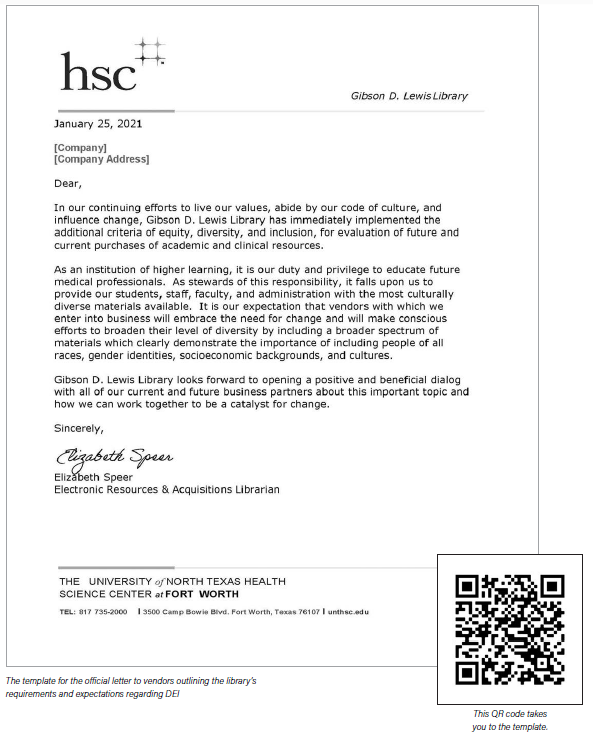Communicating with vendor representatives can be challenging in the best of times. Communicating with vendors during a collection evaluation involving diversity, equity, and inclusion (DEI) escalates those challenges. In these situations, you are potentially going to be questioning the values of an organization and the types of materials provided, as well as negotiating continued access or cancellation of resources. This has the potential to become extremely uncomfortable, with long-term ramifications on professional relationships. However, these types of interactions between librarians and vendors can, and often do, provide greater insight into the overall value of resources and create more meaningful communication interactions.
The Project
During the summer of 2020, DEI became a focus area for my institution, the Gilson D. Lewis Health Science Library at the University of North Texas. We were charged, through a lens of DEI, to provide assistance, dialogue, and awareness and to turn our vision inward toward what resources the library offers and how those resources reflect the community and patrons served. This task would bring about changes, not only in what we purchased, but also in how we communicated and made decisions about what we valued in our collection and what we selected to add to it. As a medical institution, library staff were aware of issues regarding collection diversity due to the traditionally homogenous nature of medical research. While these issues would not be resolved easily, what could be corrected quickly were policies, documentation procedures, and communication standards.
The collection evaluation occurred through data gathered about surrounding communities, our university population, and outreach services. Data was then applied to the collection evaluation process through the systematic search of visual databases to ensure diversity in images represented, individual subscription title evaluations, term searches within the discovery layer, and evaluations of collection policies and internal forms and communications. Lack of relevant metadata, staffing issues, collection depth and volume, and the historic lack of communication across campus hampered our endeavors. Internal policies and forms were easily adapted to address recognized needs and new criteria. However, the unknown factor that had the largest impact on the collection and inclusion of new DEI items was vendor communications.
Creating Communication Standards
Throughout the collection evaluation process, two things became increasingly clear: Communication had been severely lacking, and standards were an immediate necessity. We tackled internal standards first. Collection development policies, order request forms, and evaluation forms were all updated to include DEI as a purchasing factor. Once internal standards had been set, it was time to evaluate how library staff members were communicating with vendor representatives.
We agreed that, when at all possible, vendor communications should be limited to a single library representative. This would allow for concise and standardized messages to be delivered to all vendors about the new DEI inclusion criteria that was being implemented for the collection. Best practices were established for external vendor communications that included email, phone, contract negotiations, and establishments of trials for potential subscriptions. Standard templates were created so that all vendors receive exactly the same communication regarding DEI expectations and needs. Further, we decided that all new vendor representatives would have a required meeting with designated library staff at which library expectations would be specifically outlined and then summarized in a follow-up email.
The Letter
An official letter framing our requirements and expectations of DEI inclusion and practices for vendors was created as a template. The letter needed to come directly from the person who would be communicating with vendors rather than library administration. Administrators felt that having the electronic resources and acquisitions librarian draft the official library response to the DEI mandate as the designated library vendor liaison would establish open and honest communication and provide a level of trust and strength in negotiating established needs during resource acquisition.
The contents of the letter focused on the values of the university and the library, our duties as educators of future medical professionals, and our expectations of broadening the level of diversity in subscribed materials. We clearly stated that the letter was intended as a way to open a dialogue and provide a catalyst for change rather than to be viewed as an attack on vendor policies and offerings. However, it also made vendors aware that this was a necessary topic of discussion that would affect our business decisions moving forward.
An initial test group of 21 different vendors, all of whom provided either visual-based databases or subscriptions that were up for contract negotiation, received the newly created letter. The library sent the letters via email rather than through traditional postal service in order to have a record of each one so that the letters could easily be accessed, tracked, and saved electronically.
